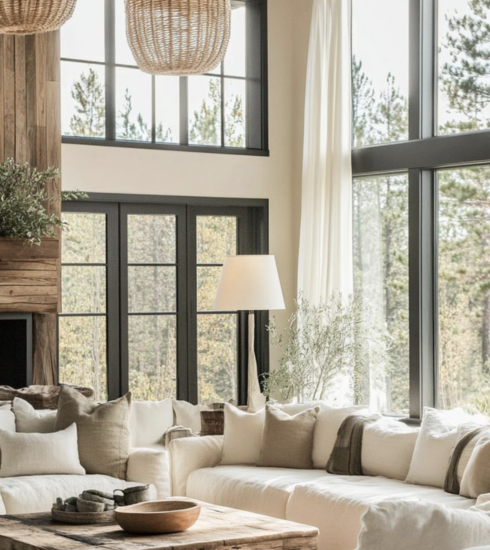The Future of Home Design: Creating Spaces That Support Your Health
Your Home Could Be Affecting Your Health—Without You Even Realizing It
We spend about 90% of our time indoors, yet most people don’t think twice about how their home environment affects their well-being. While we focus on nutrition, exercise, and stress management, our living spaces often go overlooked—even though they play a huge role in our physical and mental health.
From hidden mold and poor air quality to toxic materials and artificial lighting, the way our homes are built and maintained can either support our health—or contribute to fatigue, allergies, and even chronic conditions.
But a shift is happening. A growing number of forward-thinking architects, developers, and wellness experts are reimagining home design to create spaces that enhance health, reduce toxins, and promote overall well-being. Whether you’re buying a home, renovating, or just looking for simple upgrades, you have the power to create a home that supports your best life.
The Rise of Wellness-Focused Homes
The idea of designing homes with health in mind isn’t new, but it’s only recently started gaining real traction. According to the Global Wellness Institute (GWI), the wellness real estate market has nearly doubled since 2019 and is projected to hit $913 billion by 2028.
But here’s the thing—most homebuyers still don’t know to look for health-focused features. Instead, it’s forward-thinking developers, wellness architects, and green builders who are leading the way, proving that homes can—and should—be designed to support well-being from the ground up.
Agrihoods & Farm-to-Table Living
Another growing trend within wellness real estate is Agrihoods—residential communities built around organic and sometimes regenerative working farms. These developments prioritize sustainability, fresh food access, and community engagement, offering residents the ability to buy produce directly from the farm, participate in gardening, or simply enjoy a more nature-connected lifestyle.
For homeowners, this means access to nutrient-dense, farm-fresh food without relying on industrial supply chains. For real estate agents, it’s important to recognize that buyers seeking a healthier, more sustainable lifestyle may be drawn to these communities.
Agrihoods aren’t just for rural areas—they’re appearing in suburban and even urban settings as more developers integrate community-supported agriculture (CSA), farm-to-table dining, and wellness-driven design into modern neighborhoods.
The good news? You don’t have to move into a brand-new wellness community to benefit from these principles. Many of these health-forward ideas can be applied to any space, making your home a more nourishing place to live.
What Makes a Home Truly Supportive of Well-Being?
A home designed for wellness goes beyond aesthetics—it’s about air quality, materials, natural light, and energy flow. Here are some of the key features of a wellness-focused home:
1. Clean, Purified Air
Indoor air pollution can be 2-5 times worse than outdoor air, thanks to poor ventilation, off-gassing from furniture, and hidden mold. Developers of wellness communities integrate whole-home air filtration and humidity control to maintain healthier air. For existing homes, you can improve air quality by upgrading HVAC filters, adding high-quality air purifiers, and choosing low-VOC paints and finishes.
2. Non-Toxic, Sustainable Materials
Traditional homes often contain materials that release harmful chemicals over time, including formaldehyde and VOCs. New wellness-designed homes prioritize natural, toxin-free materials like hardwood floors, chemical-free cabinetry, and non-toxic insulation. For your own space, consider swapping out synthetic rugs and furniture for natural alternatives like wool, organic cotton, and solid wood.
3. Mold Prevention & Moisture Control
Mold is one of the most overlooked health risks in homes, contributing to allergies, fatigue, and respiratory issues. Wellness-focused homes are designed with proper ventilation, mold-resistant materials, and moisture control. If you suspect mold in your home, an air quality test can help you identify issues, and using dehumidifiers and improving airflow can reduce future risks.
4. EMF Awareness & Reduction
With the rise of smart home technology, electromagnetic fields (EMFs) are an increasing concern. While research is still evolving, some wellness communities are incorporating shielded wiring, hardwired internet options, and low-EMF sleeping areas to reduce exposure. For your own home, consider turning off Wi-Fi at night, keeping electronics out of the bedroom, and using EMF-blocking materials in sleep spaces.
5. Natural Light & Biophilic Design
Exposure to natural light improves sleep, boosts mood, and enhances productivity. Wellness communities often integrate large windows, skylights, and nature-inspired elements to create a calming, light-filled atmosphere. If your home lacks natural light, try placing mirrors to reflect sunlight, using circadian-friendly lighting, and incorporating plants to bring nature indoors.
6. Spaces That Support Physical & Mental Well-Being
A home designed for well-being encourages movement, mindfulness, and relaxation. Many wellness communities include meditation gardens, yoga studios, and wellness-oriented gathering spaces. In your own home, creating a dedicated wellness space—even a simple reading nook, meditation corner, or home gym—can help make well-being part of your daily routine.
Bringing Wellness Design into Any Home
Not everyone can live in a brand-new wellness-focused community—but everyone deserves a home that supports their health. The key is awareness and small, meaningful upgrades that can have a big impact.
If you’re looking for a home, start asking the right questions:
- How is the air quality in this home, and how can it be improved?
- What materials were used in construction, and do they off-gas chemicals?
- Has this home been tested for mold, and what moisture prevention measures are in place?
- How much natural light does the home receive, and can it be enhanced?
If you already own your home, consider working with professionals like biophilic designers, building biologists, mold specialists, and green builders who can help identify areas for improvement.
The Role of Real Estate Agents in This Growing Movement
While wellness-focused home design is being driven by developers, architects, and environmental health experts, the real estate industry is slowly catching on. More agents are beginning to recognize the value of healthier homes and are taking steps to educate their clients, expand their networks, and provide more holistic guidance.
Some agents are rising to the occasion, positioning themselves as connectors in the healthy home movement. They’re partnering with mold specialists, green building consultants, air quality experts, and sustainable designers to help clients make informed decisions—whether they’re buying a new home, selling a wellness-upgraded property, or improving their current space.
For buyers, a knowledgeable agent can help:
- Ask the right questions about air quality, materials, and home health risks.
- Connect clients with experts who specialize in healthy home assessments.
- Identify homes that already incorporate wellness features or have the potential for upgrades.
For sellers, a wellness-conscious agent can:
- Highlight wellness upgrades as premium selling points.
- Market energy-efficient and health-conscious features to attract forward-thinking buyers.
- Help justify a higher asking price for homes with wellness-focused improvements.
While not every real estate professional is familiar with these concepts yet, this movement is growing. As more people recognize the connection between home and health, the demand for knowledgeable agents—and healthier homes—will continue to rise.
The Future of Home Design Is Wellness-Centered
Wellness real estate is still in its early stages, but as more people realize the profound impact of their home on their health, the demand for wellness-oriented spaces will grow. Developers are setting the stage, but the real movement begins when individuals start making more intentional choices about where and how they live.
Your home should be more than just a place to sleep—it should be a space that restores, energizes, and supports you. Whether you’re buying, renovating, or simply making small changes, every step toward a healthier home is a step toward a healthier life.





